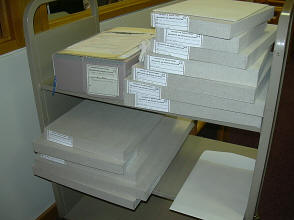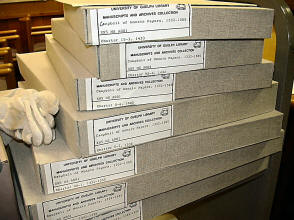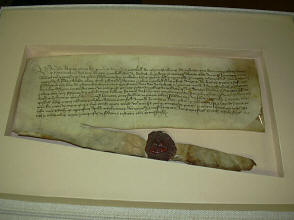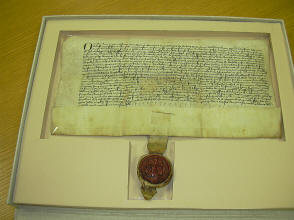|
Monzie
Castle is situated on the very edge of the Highland line midway between
Crieff and the mouth of the Sma’ Glen. The Campbells acquired the fourth
part of Monzie when Archibald son of Cohn Campbell of Glenorchy married
Margaret Toshoch eldest daughter of Andrew Toshoch of Monzie in 1581.
Archibald then sold these lands to his brother, Black Duncan of Glenorchy,
who in turn granted them to his son, another Archibald.1 As the
papers in this collection indicate Archibald was followed by his son Duncan
who died debt-ridden to be succeeded by his nephew Patrick, an individual
similarly plagued with financial troubles. Patrick’s son Cohn received a
charter of the lands of Monzie from Charles II. Cohn was in turn succeeded
by his son Patrick Lord Monzie an advocate, member of the Court of Session2
and the subject of many of the documents of this collection.
Glenorchy’s
acquisition of Monzie occurred at a period of spectacular Campbell
aggrandisement.3 Monzie, on the banks of the Shaggie Burn, was a
fertile spot as its Gaelic derivation Magh-eadh - ‘plain of corn’ -
indicates. During the eighteenth century, in the days of the great cattle
droves, thousands of head of cattle passed through the community on their
way to the trysts at Crieff. The Toshoch family into which Archibald married
derived its name from Gaelic toiseach ‘chief’ or anglice
‘thane’, the true clan name being Menzies.
Just how
the present collection came into existence is unknown. It was presented to
the university through the generosity of Dr. A.I. MacRae but the surviving
documents must represent only a small portion of what were once the Monzie
muniments. They span the period from 1416 to 1811 but owing to their
heterogeneous character only the merest indication of their range and
content is possible here.
It was
through the Menzies connection that the earliest and most interesting pieces
found their way into the collection. The oldest document in the University
of Guelph Library’s Archival Collections is a letter of Henry Sinclair, Earl
of Orkney, appointing David Menzies tutor testamentary to his heirs,
especially William, and naming Menzies governor of his men, lands, rents,
possessions and goods in Orkney until his heirs attained their majority.
Several other documents, including an indenture between Menzies and the
earl, are associated with this transaction. In a study illustrative of that
field of historiography known as speculative coincidence Frederick J. Pohl4
has argued that Earl Henry’s father and namesake led an expedition to Nova
Scotia in or around 1398. The explorer died c.l400. His successor was
captured at the battle of Homildon Hill in 1402. He enlarged his spectacular
castle at Roslin south of Edinburgh and greatly improved his estates. He was
entrusted with the task of escorting young Prince James to safety in France
in 1406 when their ship was captured by English pirates who promptly
delivered the prince, shortly to succeed as James I, to an eighteen year
imprisonment in the Tower of London. Earl Henry was soon released and he
acted on several occasions on behalf of his captured king. He issued his
letter to Menzies on 16 December 1416. Earlier that year he received a safe
conduct to travel to England which may explain why he felt compelled to make
arrangements for the well-being of his heirs.5
Sir David
Menzies (1377-1449), also known as Saint David Menzies of Weem because he
took holy orders later in life, was Earl Henry’s brother-in-law. He governed
Orkney until 1423 when he became a hostage for the payment of James I’s
ransom. It is of interest to note that a copy of the document under
discussion was extant in the charter room at Castle Menzies c.1750.6
It has not been seen since. Hence the Guelph letter is, to the best of our
knowledge, unique.
The
collection contains a number of assignments and discharges of rather
technical and local interest and dated in the main to the reigns of James VI
and Charles I. Many of these concern the domestic affairs of the Campbells
and various land transactions. There is one royal letter (1592), a notarial
instrument, a band, several financial accounts and a letter of Andrew Murray
Lord Balvaird discussing Scotland’s predicament in 1643 in the heady months
leading up to the signing of the Solemn League and Covenant.
As might be
expected, the Monzie papers contain a useful selection of estate rentals the
main interest of which derives from their illustration of pre-improvement
tenancy. The rentals preserve the names of tenants on the Monzie estates,
the names and extent of their holdings measured in acres and ploughgates
together with numerous details about the rents paid in cash or kind. There
is information about the quantities of meal and bear (an inferior barley)
produced as well as the conversion prices and the numbers of livestock,
mainly sheep and poultry. Later eighteenth century rentals such as that for
Innerpeffray (1751) show clear evidence of agricultural improvement.
A sizeable
section of the collection concerns the career of Patrick Lord Monzie.
Patrick was appointed to the Equivalent Company in 1728 which was set up to
administer the ‘Equivalent’, that sum of money - almost 400,000 pounds -
granted by the English parliament in terms of the Treaty of Union in 1707 to
compensate shareholders in the abortive Darien Scheme of the 1690s. Patrick
acquired the dead stock debts and effects of the African Company, as it was
called, since although the one disastrous colonial venture took place in
South America it was sponsored by the Company trading to Africa and the
Indies. Lord Monzie also acquired the house of the African Company in
Milne’s Square, Edinburgh, built between 1684 and 1688 by Robert Myhie,
master mason to four monarchs from the reign of Charles II to that of Queen
Anne. Several documents provide illuminating insights and minute details on
the appointment of this house noting rooms, furnishings and the rest.
Patrick’s wife, Catherine, a member of the Erskine of Alva family, became
something of a celebrity in the square where in her younger days she had
been compelled to fight off the rather unsavoury advances of Lord Lovat.7
Monzie’s involvement in the African Company may have been not unconnected
with the fact that his kinsman Daniel Campbell was secretary to the Royal
Bank of Scotland.
Despite his
apparent good fortune Patrick Lord Monzie experienced lifelong financial
problems as many of his papers indicate. Apart from detailed accounts of the
African Company the collection contains much information on his personal
debts. He had territorial disputes with Campbell of Lawers. He was forever
receiving solicitations for financial assistance from the children of
friends and neighbours in Perthshire who were anxious to make their fortunes
in England or overseas. One such was Captain Robert Haldane R.N. of the
Gleneagles family temporarily in disgrace in 1754 for having grounded his
ship in Plymouth Sound.8 Even as he asked Patrick for a loan he cheerfully
admitted the use to which it might be put
‘By this time I suppose you’l begin to think I’m
lost and indeed tis true, for ever since I have been in town the devil take
me if I know how the time has slipt away what with love, what with company
claret and other diversions I’m almost fallen into the same scrape with Mr
John Carstairs the man Jamie Murray told us of that went out to ask his own
name. . .‘
When
Patrick died in 1757 he left behind some 339 bottles of wine and to judge
from a remarkable inventory drawn up after his death, almost as many beds.
His fine house in Mylne’s Square was sold. He was succeeded by Captain
Robert Campbell of Monzie who achieved the rank of colonel before his death
in 1790. His son, Lieutenant-General Alexander Campbell petitioned to have
the entail, drawn up by Cohn Campbell of Monzie in 1676, altered. Entail
permitted someone like Cohn to dictate the destination of his estates
through succession, virtually in perpetuity. It was difficult to raise
credit on entailed estates which probably accounts for Patrick’s problems.
The final document in the collection preserves Alexander’s arguments as
presented to the Court of Session.
1
Sir J.B. Paul (ed.) Scots peerage, 9 vols. (Edinburgh, 1904-14), vol.
2, pp. 183-186.
2 George Brunton (ed.), An
historical account of the Senators of the College of Justice of Scotland
(Edinburgh, 1849), pp. 501-2, 516.
3 Edward J. Cowan, “Clanship, kinship
and the Campbell acquisition of Islay”, Scottish historical review,
vol. 58, 1979; “The Angus Campbells and the origins of the Campbell-Ogilvie
feud”, Scottish studies 25, 1981.
4
Frederick J. PohI, Prince Henry Sinclair: his expedition to the New World
in
1398 (New York, 1974), passim.
5
Scots peerage, vol. 6, p. 570.
6 D.P. Menzies, The red and white
book of Menzies: the history of Clan Menzies and its Chiefs (Glasgow,
1894), pp. 100-111.
7
Wilmot Harrison, Memorable Edinburgh houses (Edinburgh, 1898), p. 19.
8
Sir J. Aylmer, L. Haldane, The Haldanes of Gleneagles (Edinburgh,
1929), pp. 184-187.
EDWARD J.
COWAN



 |
